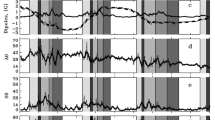Abstract
Polar coronal holes are large-scale configurations with open magnetic fields on the surface of the Sun. They are most active during the period of minimum solar activity and almost disappear during the period of maximum solar activity. We present the evolution of two coronal holes that were observed during the polarity reversal of cycle 23. Data were taken from SOHO/MDI/fd and SOHO/EIT/284 Å. These coronal holes had the polarity of the next, 24th, cycle. Instead of localization at the pole, in both cases, the propagation of coronal holes to the opposite hemisphere was observed. Thus, the open magnetic fields actively interacted with the toroidal magnetic field of the active regions during the polarity reversal period.
Similar content being viewed by others
Avoid common mistakes on your manuscript.
1 INTRODUCTION
Our existence is determined by the nearest star to us: the Sun. This determines the importance of solar research both in the applied aspect and from the point of view of fundamental science. The sun, as a star, has a convective envelope and magnetic field. These factors determine the activity of the Sun: the constant convective motions of plasma penetrated by a magnetic field create conditions for changes (generation and dissipation) of magnetic fields over a wide range of spatial and temporal scales, as well as conditions for the cyclical evolution of solar activity. It follows from solar dynamo models that the dipole component of the Sun’s global magnetic field is at a maximum during solar cycle minima, while its magnetic flux is concentrated at the poles, forming the so-called polar coronal holes. We note that a coronal hole (CH) is a vast region on the surface of the Sun with reduced intensity in X-ray and ultraviolet radiation. CHs are considered as sources of high-speed solar wind. The magnetic field in them is predominantly open, although inclusions of closed fields can also occur (Chertok et al., 2002; Bugaenko et al., 2004). A detailed definition of CH was given in (Obridko and Nagovitsyn, 2017).
During the cycle, the poloidal field turns into a toroidal one (generating active regions), while the area of polar CHs decreases, and at the maximum of the cycle, a change in their polarity, the so-called polarity reversal, is observed. Subsequently, the areas of polar CHs grow and reach their maximum in the subsequent minimum of cyclic activity. For a more detailed review, one can recommend, in particular, the works (Obridko and Shelting, 1999; Cranmer, 2009; Wang, 2009). In this chain, the polarity reversal process is the weakest link both in theoretical and observational aspects. The question remains: where is the magnetic flux of coronal holes localized during the polarity reversal period and how does it move over the surface of the Sun? We considered this question using the examples of two long-lived CHs during the period of polarity reversal of the 23rd cycle. A polarity reversal took place approximately from the middle of 2000 to the end of 2001, see, for example, Fig. 2 in (de Toma, 2011).
2 THE EVOLUTION OF POLAR HOLES DURING THE POLARITY REVERSAL
We used SOHO/MDI/fd and SOHO/EIT/284 Å data. Figure 1 shows the evolution of a CH that originated in June 2000 near the north pole (Fig. 1, panels a, b; in all panels, the white contour outlines the coronal hole). The CH polarity is negative (marked in black on MDI maps); this is the polarity that should occur at the north pole after the polarity reversal. According to theoretical concepts, it should continue to be localized at the pole and collect open fields of negative polarity around itself. However, observations show a completely different dynamics: The CH persistently spreads to the south, reaches the equator and descends into the southern hemisphere up to latitudes of about 50 degrees. We can observe active regions (ARs) around the CH while it is moving, sometimes it “squeezes” between two ARs (for example, panels e, f). Often near the border of the CH, outside, there is a field of the same polarity, but these zones are not included in the CH, they are covered with closed loops (as the EIT map shows, see for example panels c, d). Thus, the open field of the CH is squeezed by high loops of closed fields and comes into contact with the magnetic flux separation surfaces.
The longitudinal magnetic field density B0, averaged (with a sign) over the entire area of the CH, varies from revolution to revolution within a range of (–2.1, –6.8) Mx/cm2 (by more than 3 times, see the top line of inscriptions on the panels of Fig. 1). The same value, but summed over the area except for the bright coronal points inside the CH, differs from the above one by less than 6% in all cases. Thus, the large scatter of B0 does not depend on small inclusions and is, apparently, real. The density of the total longitudinal magnetic flux Btot (the average of the absolute values of the densities of the longitudinal field, the bottom line of the inscriptions on the panels of Fig. 1) varies within (18.3, 24.0) Mx/cm2. The area occupied by the coronal hole varies within (1.8, 11.4) × 104 MDI pixels (1 pixel is 2 × 2 arcseconds, or 1.45 × 1.45 megameters at the center of the solar disk), i.e., about 6 times. (Note that the change in the area due to the inclusion/noninclusion of bright points is no more than 5%).
Figure 2 shows an example of a CH in the southern hemisphere. This case was considered in detail in (Pevtsov and Abramenko, 2009). The south polarity CH first appeared at the south pole on November 12, 2001 (panel a). Its polarity (south) corresponded to the new (after polarity reversal) polarity of the open magnetic field at the south pole. As well, as in the previous case, the CH did not remain localized near the south pole, but began to rapidly propagate toward the equator (panels a, b), and then into the northern hemisphere (panels c, e). In this CH, the connection with the south pole was maintained for five revolutions (panels a, e), and such a connection was no longer observed only on the last revolution (panel f). As in the previous case, ARs were observed around the coronal hole, as well as elongated ribbons of fields of opposite polarities connected by loops visible in the EIT images (panels d, f). Thus, the open CH field tended to the most active equatorial zones during the period of maximum activity.
The behavior of the CH magnetic field parameters is essentially the same as in the previous case. B0 varies within (2.3, 12.2) Mx/cm2 (about 5 times), Btot changes less, from 21.0 to 27.0 Mx/cm2 , and the CH area varies in the interval (4.9, 11.9) × 104 MDI pixels, i.e., about 2.4 times. Note that here, too, the discrepancies in the estimation of the parameters due to the inclusion/noninclusion of bright points do not exceed 3–5%.
3 DISCUSSION AND CONCLUSIONS
Wang and Sheeley (2004) presented the interchange reconnection model: a model of magnetic flux tubes interaction when open and closed magnetic field lines reconnect in the supraphotospheric layers. This model makes it possible to explain the formation and evolution of coronal holes and how footpoints of open field lines can move across the solar disk. The behavior of coronal holes observed in the present work corresponds to this model. The main conclusion of this work can be formulated as follows. A high level of fluctuations of the CH parameters (density of the net and total fluxes, area, localization on the disk) indicates that although morphologically the CH looks like the same coronal hole, its magnetic imprint on the photosphere is constantly changing, which supports the idea that the CH is not a deep formation. Most likely, the mechanism proposed by Wang and Sheeley (2004) determines the behavior of the CH.
The second conclusion of this study can be formulated as follows: during the period of maximum activity, or rather, during the period of polarity reversal, an open magnetic flux penetrates into the zone of low latitudes as a single-connected structure (single CH) and takes a direct part in the processes of the activities. This means that the interaction between the open and toroidal fields is inevitable (according to the model of Wang and Sheeley (2004), there exists reconnection between open CH fields and closed loops of ARs).
The revealed here property of CH to avoid vast regions of closed fields of the same polarity suggests that the movements of coronal holes are restrained by separatrices of magnetic fluxes in the corona.
We note in this regard that studies of global activity complexes (Obridko and Shelting, 2013; Malashchuk et al., 2012), consisting of local (active regions) and large-scale (coronal holes) manifestations of the magnetic field, can shed light on the role of coronal holes in magnetic activity at low latitudes. It is possible that CH localization at low latitudes during the period of the activity maximum is an essential part of the conditions for an increased release of magnetic energy in nonstationary processes in the chromosphere and corona during this period. For the subphotospheric layers, if the roots of open magnetic fields lie in the same depth range as the ARs roots, then it can be assumed that the field of coronal holes, as a manifestation of global magnetic fields, is quite capable of organizing and controlling large-scale activity complexes, as suggested in works led by N.N. Stepanyan (Malashchuk et al., 2011, 2012), see also (Obridko and Nagovitsyn, 2017).
REFERENCES
Bugaenko, O.I., Zhitnik, I.A., Ignat’ev, A.P., et al., Study of solar formations on the basis of integrated observations from the Earth and KORONAS-F satellite: II. Magnetic fields in coronal holes at various altitudes, Izv. Krym. Astrofiz. Obs., 2004, vol. 100, pp. 123–130.
Chertok, I.M., Mogilevsky, E.I., Obridko, V.N., et al., Solar disappearing filament inside a coronal hole, Astrophys. J., 2002, vol. 567, pp. 1225–1233.
Cranmer, S.R., Coronal holes, Living Rev. Sol. Phys., 2009, vol. 6, pp. 3–66.
Malashchuk, V.M., Rudenko, G.V., Stepanyan, N.N., et al., Relation of coronal holes with structures of large-scale magnetic fields, Izv. Krym. Astrofiz. Obs., 2011, vol. 107, pp. 89–98.
Malashchuk, V.M., Fainshtein, V.G., Stepanyan, N.N., et al., Magneto-isolated complexes of solar formations, Izv. Krym. Astrofiz. Obs., 2012, vol. 108, no. 1, pp. 105–114.
Obridko, V.N. and Nagovitsyn, Yu.A., Solnechnaya aktivnost’, tsiklichnost’ i metody prognoza (Solar Activity, Cyclicity, and Forecast Methods), St. Petersburg: VVM, 2017.
Obridko, V.N. and Shelting, B.D., Global complexes of activity, Astron. Rep., 2013, vol. 57, pp. 786–796.
Obridko, V.N. and Shelting, B.D., Structure and cyclic variations of open magnetic fields in the Sun, Sol. Phys., 1999, vol. 187, pp. 185–205.
Pevtsov, A.A. and Abramenko, V.I., Transport of open magnetic flux between solar polar regions, in Proceedings of IAU Symposium 264 “Solar and Stellar Variability: Impact on Earth and Planets”, Kosovichev, A.G., Andrei, A.H., and Rozelot, J.-P., Eds., Cambridge University Press, 2009, pp. 210–212.
de Toma, G., Evolution of coronal holes and implications for high-speed solar wind during the minimum between cycles 23 and 24, Sol. Phys., 2011, vol. 274, pp. 195–217.
Wang, Y.-M., Coronal holes and open magnetic flux, Space Sci. Rev., 2009, vol. 144, pp. 383–399.
Wang, Y.-M. and Sheeley, N.R., Footpoint switching and the evolution of coronal holes, Astrophys. J., 2004, vol. 612, pp. 1196–1205.
Author information
Authors and Affiliations
Corresponding authors
Ethics declarations
The authors declare that they have no conflicts of interest.
Rights and permissions
About this article
Cite this article
Abramenko, V.I., Biktimirova, R.A. Magnetic Field of Coronal Holes During the Polarity Reversal. Geomagn. Aeron. 62, 869–872 (2022). https://doi.org/10.1134/S0016793222070039
Received:
Revised:
Accepted:
Published:
Issue Date:
DOI: https://doi.org/10.1134/S0016793222070039






